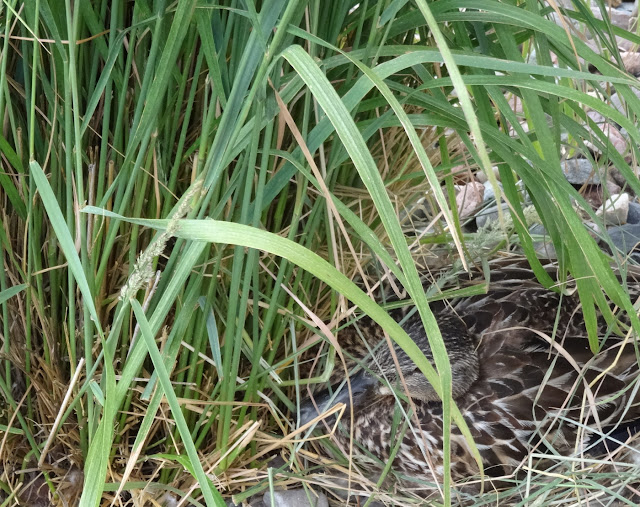6/22/2021
nesting mallard
5/21/2021
hooded merganser ducklings
Today the Hooded Merganser female showed up on the pond with 15 ducklings. This species nests in a cavity, probably in a tree or stump nearby. Once the eggs hatch, the ducklings follow the mother to water. They fed for a while, then she signaled them to rest. They followed her to shore and gathered under her wings. Well, sort of . . . there were many of them!
They dive under water to find small fish, amphibians, clams, mud crabs, crayfish, tadpoles, frogs, and aquatic insects and other crustaceans. They also consume some aquatic plants.
5/05/2021
blue-winged teal pair
4/21/2021
blue-wing teal
4/09/2021
hooded mergansers
3/12/2021
mallards' finest feathers
Mallards arrived this week on the pond. Last year, after nesting and before migrating, mallard ducks molted: each lost and replaced all of their feathers with new drab plumage. This is considered their 'basic plumage.' In the early spring, just before breeding season, they shed some feathers and put on their handsome 'alternate plumage' to look more attractive and help attract a mate.
11/08/2020
dabbling ducks
10/28/2020
water sports
Sunny and warmer, closer to normal weather today, after an early snow in October. Several Mallards are getting ready for their travel south by feeding on the dwindling supply of plant material in the pond. But the resident muskrats do not like to share their food supply. We watched several encounters today between the animals.
10/20/2020
slush trail
Snow! Several inches. Before we were ready for it. Before the Mallards were ready for it. As they paddled around on the pond to find breakfast, they made a trail in the accumulating slush on the water.
10/16/2020
10/08/2020
diving ducks
Mergansers stopped on the pond for a rest. They floated in the early sunlight for a while, then dived under water to search for a meal. Maybe they found aquatic insects, worms, frogs, or snails.
Below, the duck on the right is just gathering her body upward to curve down and dive. Because feathers make ducks buoyant, it takes muscles to dive. The one on the left is just emerging from a dive, as the water rolls off her head.
9/10/2020
ducks in September
Mallards, dabbling ducks who rely on ponds like this one, have been growing and feeding in nearby crop fields while they molted into new feathers. Now we see them on the pond more often than in mid-summer. It is our signal to watch for daily duck visits as they prepare for migration.
9/05/2020
Birds seek quiet hidden places while they molt into new feathers each year after nesting season. Here in Minnesota, most birds have passed that phase. So, again we are seeing dabbling ducks and diving ducks visit the pond. Early this morning, three Mergansers were floating on calm water warming themselves in the sunlight. After a while they began diving to find food. They eat fish, mollusks, aquatic insects, and plants. This one was poised to dive, with her wings up, feet back, and bill ready to lead her into the water.
5/15/2020
Mallard ducklings
The female Mallard appeared on the pond today with 11 ducklings in tow. It is hard to tell exactly how many hours old they are since we did not track the nest or hatch time. They stayed by Mom at first, but all swam vigorously as they got used to the water.
4/22/2020
mallard
Female Mallard frolicking on the water? Not a frolic -- she was having a bath. Standing on a submerged rock, she dipped her bill and dabbed her feathers with water. Later she swam to the shore and tidied herself on the sunny grass. Ducks such as Mallards (Anas platyrhynchos) have a preen gland that produces oil. Using the bill, they smooth their feathers and spread the preen oil to condition them. All birds need to maintain their plumage . . . re-position feathers, interlock feather barbules that have become separated, and remove parasites from their body or plumage.
4/17/2020
Hooded Merganser defending territory
4/14/2020
Blue-winged Teal
Blue-winged Teal are also dabbling ducks, but smaller than the Mallards we frequently see on the pond.
They eat vegetation and grains, but in nesting season look for aquatic insects and larvae, crustaceans, clams, and snails.
This male was accompanied by a female and she wandered into the reeds to feed there.
4/12/2020
spring thaw
4/10/2020
foursome for lunch
We've seen a pair of Hooded Mergansers on the pond each day at various times.
This time, two pairs find lunch on the pond.
They come and go, so probably making the rounds of all the underwater buffets.
We are looking forward to nesting season; this species usually look for a cavity to lay their eggs.






















